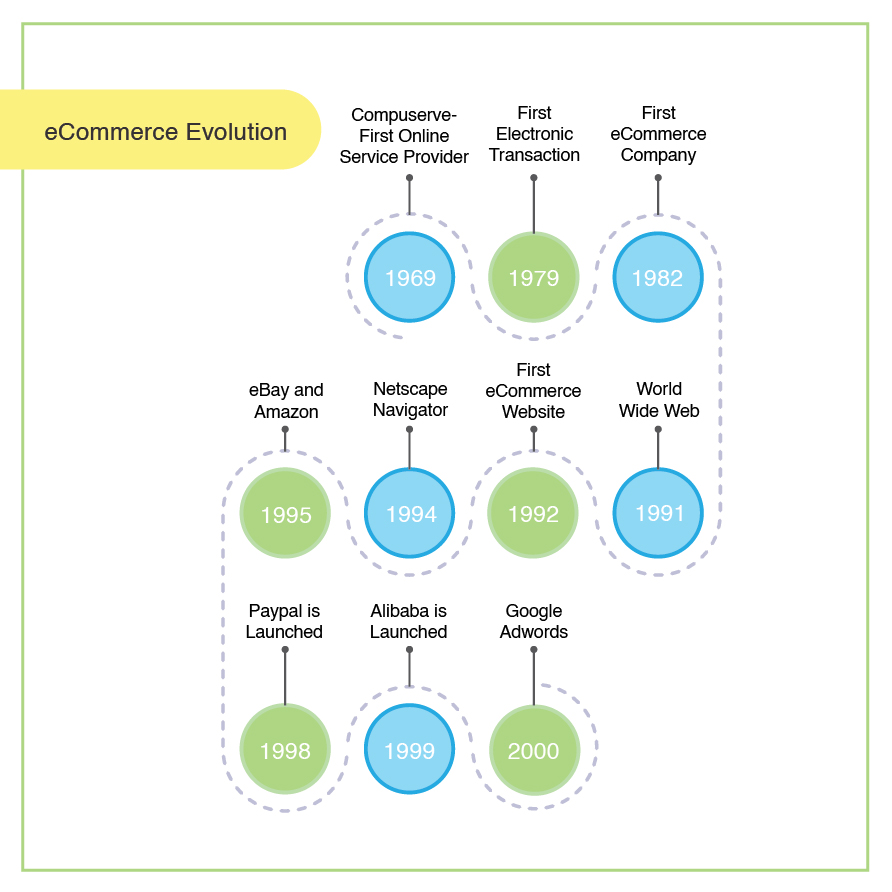Twenty years ago, if someone had told you about a way of doing business online – through the internet – you probably would have laughed it off. For a concept that was entirely novel back in the day, eCommerce has come a long way. And it’s here to stay.
What is eCommerce?
The concept of eCommerce refers to ‘selling goods via the internet.’ The advent of eCommerce has given rise to several eCommerce marketplaces, platforms, and websites.
eCommerce marketplace:
You might have used this term interchangeably with eCommerce platforms and sites. However, all these terms differ in their meanings and purposes. eCommerce marketplaces allow businesses to display and sell their products/services via the site. For instance, Amazon allows vendors to create “listings” for their products/services.
eCommerce platform:
On the other hand, eCommerce platforms help vendors and businesses set up their eCommerce websites wherein they can manage all their operations.

The Dawn of eCommerce
It all started in 1991 when the internet was made available for commercial use. By the year 2000, security protocols (like HTTP) and DSL (Digital Subscriber Line) were implemented. These protocols ensured secure electronic transactions and good internet access. The US and Western Europe, saw a big boom in the number of businesses that leveraged the internet to sell goods.
Encouraged by people’s adoption of internet selling, investors and businesses started putting their money on the internet. This period of the rise of the internet and extreme speculation in the market led to the dotcom collapse, also referred to as dotcom clash or dotcom bubble which began in the late 1990s, and lasted till 2004.
Several online shopping and communication companies were forced to shut down. On the other hand, some companies like Amazon, eBay, Qualcomm, and Cisco took a hit but managed to survive.
A Brief Timeline
Here’s an at-a-glance timeline of how eCommerce has evolved into the kind we’ve come to depend on today:

1969: Compuserve – first online service provider – is launched.
1979: Michael Aldrich invents electronic shopping and makes the first electronic transaction.
1982: World’s first eCommerce company, Boston Computer Exchange, is started.
1991: The world wide web is invented.
1992: First eCommerce website – an online bookstore – Book Stacks Unlimited is launched.
1994: Netscape Navigator – an online web browser – is launched.
1995: eBay and Amazon are launched.
1998: Paypal is launched, and it revolutionises online payment processes.
1999: Alibaba – a frontier in eCommerce brands – is launched.
2000: Google Adwords – the first online search advertising tool – helps retailers advertise their products/services.
In the next 17 years, the eCommerce industry was introduced to eCommerce sites like Amazon Prime, Etsy, Square Inc, Apple Pay, etc. and marketing events like Cyber Mondays.
Challenges Faced
By the early 2000s, small and large businesses around the world had embraced eCommerce. However, before they managed to streamline all their processes, eCommerce faced a lot of challenges.
Payments
Before Paypal introduced its online payment platform, retailers lacked secure platforms through which their customers could pay for their products or services. In the absence of online payments, retailers had to compensate for the ‘cost gap’ until the customer paid for the product during delivery.
Taxes
While eCommerce pushed geographical boundaries for retailers across the world, it also meant adhering to the tax laws and regulations of each country and state. The US has a kind of “consumption tax” for eCommerce sales. This sales tax is to be paid by the consumers on the taxable items they buy online. Add to this the fact that some districts or local areas in states are allowed to have their own sales tax.
For instance, the sales tax for Rhinebeck, New York, looks like this:

The vendors or online sellers then charge their consumers accordingly, collect the taxes, and return the amount to the state. If you are selling goods online in the USA, you must be aware of the different sales taxes levied in all states and local areas within the states.

Thus, the total amount consumers pay for a specific product/service varies for different states. In some states, they might end up paying more for the same product. These additional costs make it difficult for retailers to sell specific products/services online.
Logistics
The biggest challenge that came with delivering products at the customers’ doorsteps was hiring third-party carriers. Retailers paid those carriers for delivering products to customers within a short time frame.
Carriers added another small cost, in the form of “delivery charges,” to the total amount customers paid the retailers. While big eCommerce brands could afford the shipping services of FedEx and UPS, small brands found it difficult to manage their supply chain.
Quite recently, Amazon introduced its own shipping service that is set to provide services at a more competitive cost.
eCommerce Localisation
Today, there’s a multitude of eCommerce brands and platforms competing for their share of the consumer market. The best way to ensure that your eCommerce brand stands out in the crowd is by providing a personalised experience for every customer.
The best eCommerce experiences customers have had are the ones where they’ve interacted with a site, platform or product in a familiar environment. This familiar environment is constructed with what we call eCommerce localisation.
eCommerce localisation providers take into account your customers’ language and cultural preferences. It helps you build trust with your customers, increase your brand’s recall value, and eventually help customers with their buying decision. Also, receiving information in their language makes it easier for them to compare products and make an informed buying decision.
Conclusion
Like most innovations, eCommerce was a solution to a specific problem. Popular brands had the resources to market and sell their products in different parts of the world. On the other hand, medium and small businesses were forced to limit themselves to local markets. eCommerce provided an opportunity for such businesses to reach potential customers in all parts of the world.
By the year 2020, eCommerce sales all around the world are predicted to exceed $650 billion. eCommerce isn’t just revolutionising the way we buy goods but also the customer experience associated with different brands.
In the next article of this series, we’ll be sharing some important lessons that’ll help you find success with eCommerce localisation.


